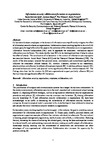Information security collaboration formation in organisations
| dc.contributor.author | Sohrabi Safa, N | en |
| dc.contributor.author | Maple, C | en |
| dc.contributor.author | Watson, T | en |
| dc.contributor.author | Furnell, SM | en |
| dc.date.accessioned | 2018-01-08T11:39:30Z | |
| dc.date.available | 2018-01-08T11:39:30Z | |
| dc.date.issued | 2017-12-14 | en |
| dc.identifier.issn | 1751-8709 | en |
| dc.identifier.uri | http://hdl.handle.net/10026.1/10487 | |
| dc.description.abstract |
Collaboration between employees in the domain of information security efficiently mitigates the effect of information security attacks on organisations. Collaboration means working together to do or to fulfil a shared goal, the target of which in this paper is the protection of the information assets in organisations. Information Security Collaboration (ISC) aims to aggregate the employees’ contribution against information security threats. This study clarifies how ISC is to be developed and how it helps to reduce the effect of attacks. The socialisation of collaboration in the domain of information security applies two essential theories: Social Bond Theory (SBT) and the Theory of Planned Behaviour (TPB). The results of the data analysis revealed that personal norms, involvement, and commitment significantly influence the employees’ attitude towards ISC intention. However, contrary to our expectation, attachment does not influence the attitude of employees towards ISC. In addition, attitudes towards ISC, perceived behavioural control, and personal norms significantly affect the intention towards ISC. The findings also show that the intention for ISC and organisational support positively influence ISC, but that trust does not significantly affect ISC behaviour. | en |
| dc.format.extent | ? - ? (11) | en |
| dc.language.iso | en | en |
| dc.publisher | Institution of Engineering and Technology | en |
| dc.subject | Information security | en |
| dc.subject | Collaboration | en |
| dc.subject | Risk | en |
| dc.title | Information security collaboration formation in organisations | en |
| dc.type | Journal Article | |
| plymouth.publication-status | Published online | en |
| plymouth.journal | IET Information Security | en |
| dc.identifier.doi | 10.1049/iet-ifs.2017.0257 | en |
| plymouth.organisational-group | /Plymouth | |
| plymouth.organisational-group | /Plymouth/Faculty of Science and Engineering | |
| plymouth.organisational-group | /Plymouth/Users by role | |
| dcterms.dateAccepted | 2017-12-12 | en |
| dc.identifier.eissn | 1751-8717 | en |
| dc.rights.embargoperiod | Not known | en |
| rioxxterms.versionofrecord | 10.1049/iet-ifs.2017.0257 | en |
| rioxxterms.licenseref.uri | http://www.rioxx.net/licenses/all-rights-reserved | en |
| rioxxterms.licenseref.startdate | 2017-12-14 | en |
| rioxxterms.type | Journal Article/Review | en |


